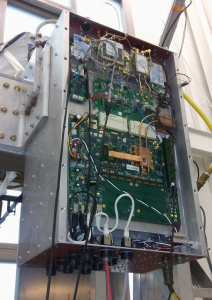
The three flight detector arrays, shown with their respective detector counts. The detectors are arranged in crossed pairs to simultaneously sample horizontal and vertical polarization. Each pair is fed by a single feedhorn.
The BLAST-TNG receiver is based on Microwave Kinetic Inductance Detectors (MKIDS). MKID detectors are superconducting resonators that change their resonant frequency in response to the absorption of incident photons that have enough energy to break apart superconducting Cooper pairs. Arrays of MKIDs are highly multiplexable and represent a promising detector technology for the next generation of balloon-borne and space-based Far-Infrared (FIR) missions. The BLAST-TNG detectors are the first implementation of dual-polarization-sensitive MKIDs. Each spatial pixel senses both X and Y linear polarizations.
The detector readout is based around a set of five, 1024-channel digital filterbank spectrometers. For this readout system architecture, the number of channels in the filterbank corresponds directly to the maximum number of resonators that can be read out simultaneously. It is based on the second-generation Reconfigurable Open Architecture Computing Hardware (ROACH-2), an open source digital signal processing platform developed by the Collaboration for Astronomical Signal Processing and Electronics Research (CASPER). BLAST-TNG will mark the first time that such a readout platform has been flown on a long duration balloon flight.





